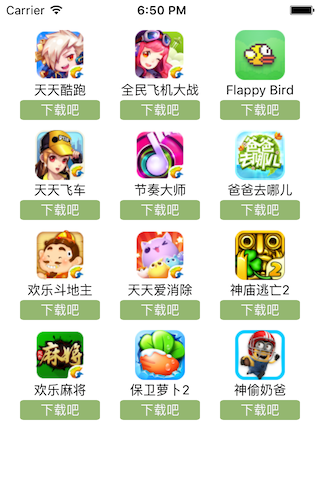IOS 应用程序管理的实现 1. 项目名称:应用管理 2. 项目截图展示 3. 项目功能 展示应用图标,名称和下载按钮 点击下载按钮,出现“正在下载”图标 4. 项目代码 模型代码:AppInfo.h #im
IOS 应用程序管理的实现
1. 项目名称:应用管理
2. 项目截图展示

3. 项目功能
展示应用图标,名称和下载按钮
点击下载按钮,出现“正在下载”图标
4. 项目代码
模型代码:AppInfo.h
#import <Foundation/Foundation.h> #import <UIKit/UIKit.h> @interface AppInfo : NSObject @property (nonatomic, copy) NSString *name; @property (nonatomic, copy) NSString *icon; @property (nonatomic, strong, readonly) UIImage *image; /** 使用字典实例化模型 */ - (instancetype)initWithDict:(NSDictionary *)dict; /** 快速实例化一个对象 */ + (instancetype)appInfoWithDict:(NSDictionary *)dict; /** 返回所有plist中的数据模型数组 */ + (NSArray *)appList; @end
模型代码:AppInfo.m
#import "AppInfo.h"
@implementation AppInfo
// 合成指令,主动指定属性使用的成员变量名称
@synthesize image = _image;
//图片模型
- (UIImage *)image
{
if (_image == nil) {
_image = [UIImage imageNamed:self.icon];
}
return _image;
}
- (instancetype)initWithDict:(NSDictionary *)dict
{
self = [super init];
if (self) {
// 用字典给属性赋值
// self.name = dict[@"name"]; //将字典的内容赋值给属性
// self.icon = dict[@"icon"];
[self setValuesForKeysWithDictionary:dict];
}
return self;
}
+ (instancetype)appInfoWithDict:(NSDictionary *)dict
{
return [[self alloc] initWithDict:dict];
}
+ (NSArray *)appList
{
NSArray *array = [NSArray arrayWithContentsOfFile:[[NSBundle mainBundle] pathForResource:@"app.plist" ofType:nil]];
// 创建一个临时可变数组
NSMutableArray *arrayM = [NSMutableArray array];
// 遍历数组,依次转换模型
for (NSDictionary *dict in array) {
[arrayM addObject:[AppInfo appInfoWithDict:dict]];
}
return arrayM;
}
@end
模型View:AppView.h
#import <UIKit/UIKit.h> @class AppInfo; @interface AppView : UIView /** 类方法,方便调用视图 */ + (instancetype)appView; /** 实例化视图,并使用appInfo设置视图的显示 */ + (instancetype)appViewWithAppInfo:(AppInfo *)appInfo; // 自定义视图中显示的数据来源是数据模型 // 使用模型设置自定义视图的显示 @property (nonatomic, strong) AppInfo *appInfo; @end
模型View:AppView.m
#import "AppView.h"
#import "AppInfo.h"
@interface AppView()
@property (weak, nonatomic) IBOutlet UIImageView *iconView;
@property (weak, nonatomic) IBOutlet UILabel *label;
@end
@implementation AppView
//实例化xib
+ (instancetype)appView
{
return [[[NSBundle mainBundle] loadNibNamed:@"AppView" owner:nil options:nil] lastObject];
}
//根据模型实例化xib
+ (instancetype)appViewWithAppInfo:(AppInfo *)appInfo
{
// 1. 实例化一个视图
AppView *view = [self appView];
// 2. 设置视图的显示
view.appInfo = appInfo;//包含,AppView有appInfo的属性
// 3. 返回视图
return view;
}
/**
利用setter方法设置视图的界面显示
*/
- (void)setAppInfo:(AppInfo *)appInfo
{
_appInfo = appInfo;
self.label.text = appInfo.name;
self.iconView.image = appInfo.image;
}
/** 按钮监听方法 */
- (IBAction)click:(UIButton *)button
{
// 添加一个UILabel到界面上
UILabel *label = [[UILabel alloc] initWithFrame:CGRectMake(80, 400, 160, 40)];
// 数值是0表示黑色,1表示纯白;alpha表示透明度
label.backgroundColor = [UIColor colorWithWhite:0.0 alpha:0.2];
label.text = self.appInfo.name;
label.textAlignment = NSTextAlignmentCenter;
// self.superview就是视图控制器中的self.view
[self.superview addSubview:label];
// 动画效果
label.alpha = 0.0;
// 禁用按钮,如果点击了按钮以后就禁用按钮
button.enabled = NO;
// 动画结束之后删除
[UIView animateWithDuration:1.0f animations:^{
// 要修改的动画属性
label.alpha = 1.0;
} completion:^(BOOL finished) {
[UIView animateWithDuration:1.0 animations:^{
label.alpha = 0.0;
} completion:^(BOOL finished)
[label removeFromSuperview];
}];
}];
}
@end
ViewController.m
#import "ViewController.h"
#import "AppInfo.h"
#import "AppView.h"
#define kAppViewW 80
#define kAppViewH 90
#define kColCount 3
#define kStartY 20
@interface ViewController ()
/** 应用程序列表 */
@property (nonatomic, strong) NSArray *appList;
@end
@implementation ViewController
- (NSArray *)appList
{
if (_appList == nil) {
_appList = [AppInfo appList];
}
return _appList;
}
- (void)viewDidLoad
{
[super viewDidLoad];
// 搭建九宫格
// 320 - 3 * 80 = 80 / 4 = 20
CGFloat marginX = (self.view.bounds.size.width - kColCount * kAppViewW) / (kColCount + 1);
CGFloat marginY = 10;
for (int i = 0; i < self.appList.count; i++) {
// 行
int row = i / kColCount;
// 列
int col = i % kColCount;
CGFloat x = marginX + col * (marginX + kAppViewW);
CGFloat y = kStartY + marginY + row * (marginY + kAppViewH);
//加载第i个xib视图
AppView *appView = [AppView appViewWithAppInfo:self.appList[i]];
// 设置视图位置
appView.frame = CGRectMake(x, y, kAppViewW, kAppViewH);
[self.view addSubview:appView];
}
}
5. 本项目必须掌握的代码段
字典转模型
- (instancetype)initWithDict:(NSDictionary *)dict
{
self = [super init];
if (self) {
[self setValuesForKeysWithDictionary:dict];
}
return self;
}
+ (instancetype)appInfoWithDict:(NSDictionary *)dict
{
return [[self alloc] initWithDict:dict];
}
+ (NSArray *)appList
{
NSArray *array = [NSArray arrayWithContentsOfFile:[[NSBundle mainBundle] pathForResource:@"app.plist" ofType:nil]];
// 创建一个临时可变数组
NSMutableArray *arrayM = [NSMutableArray array];
// 遍历数组,依次转换模型
for (NSDictionary *dict in array) {
[arrayM addObject:[AppInfo appInfoWithDict:dict]];
}
return arrayM;
}
KVC
[self setValuesForKeysWithDictionary:dict];
6. 笔记
字典转模型:
plist文件有多个字典,把字典的元素转换成模型类对象的成员变量,将模型类对象放入数组中 模型的属性名称和plist文件中的key名称必须一致
如有疑问请留言或者到本站社区交流讨论,感谢阅读,希望能帮助到大家,谢谢大家对本站的支持!
